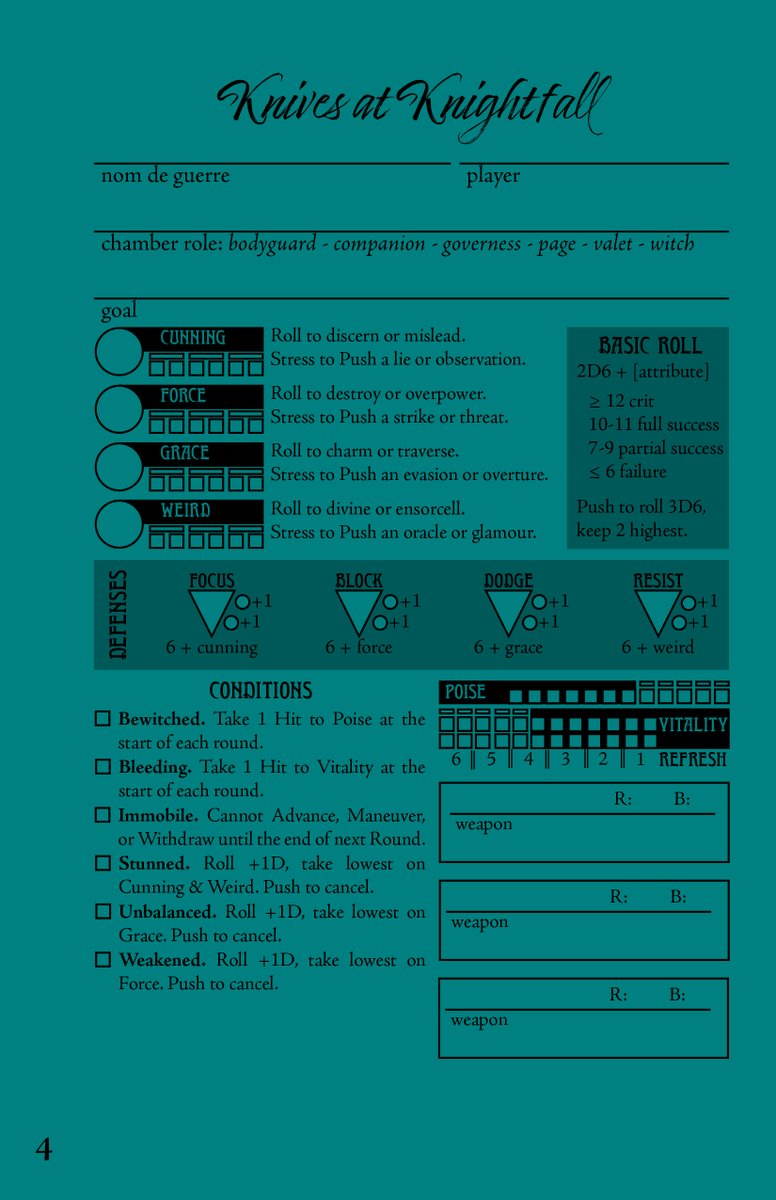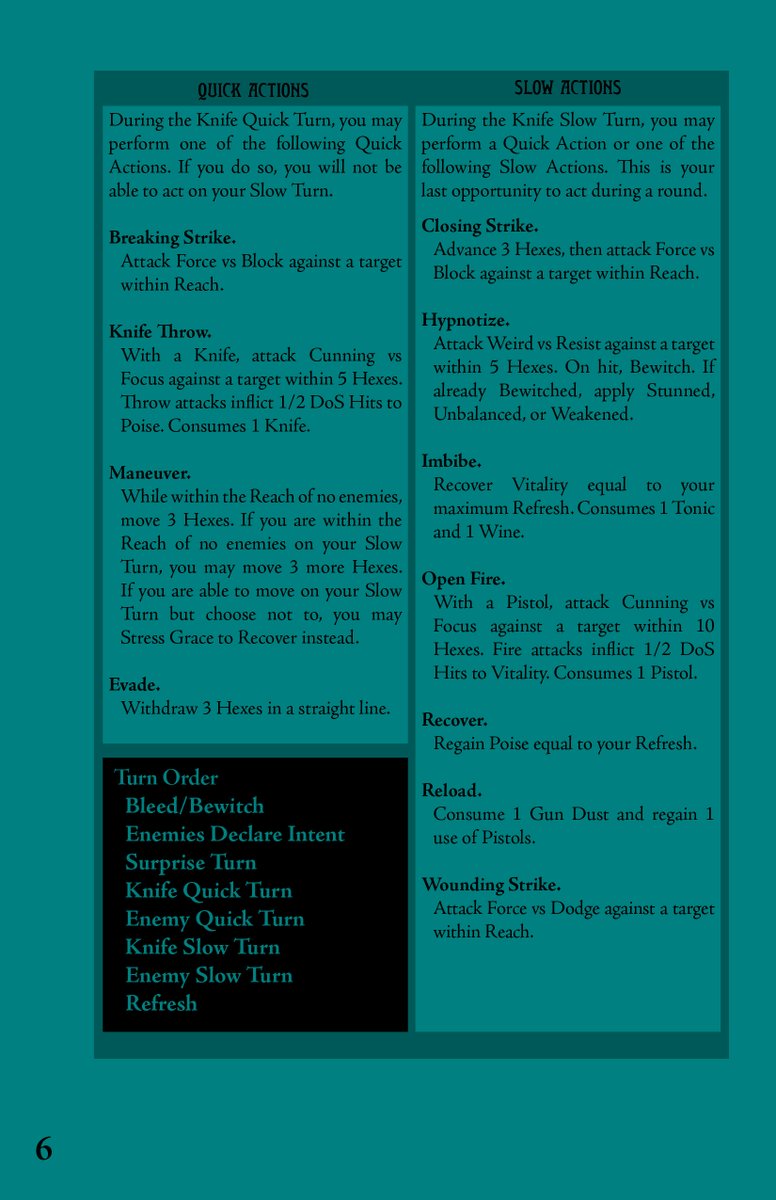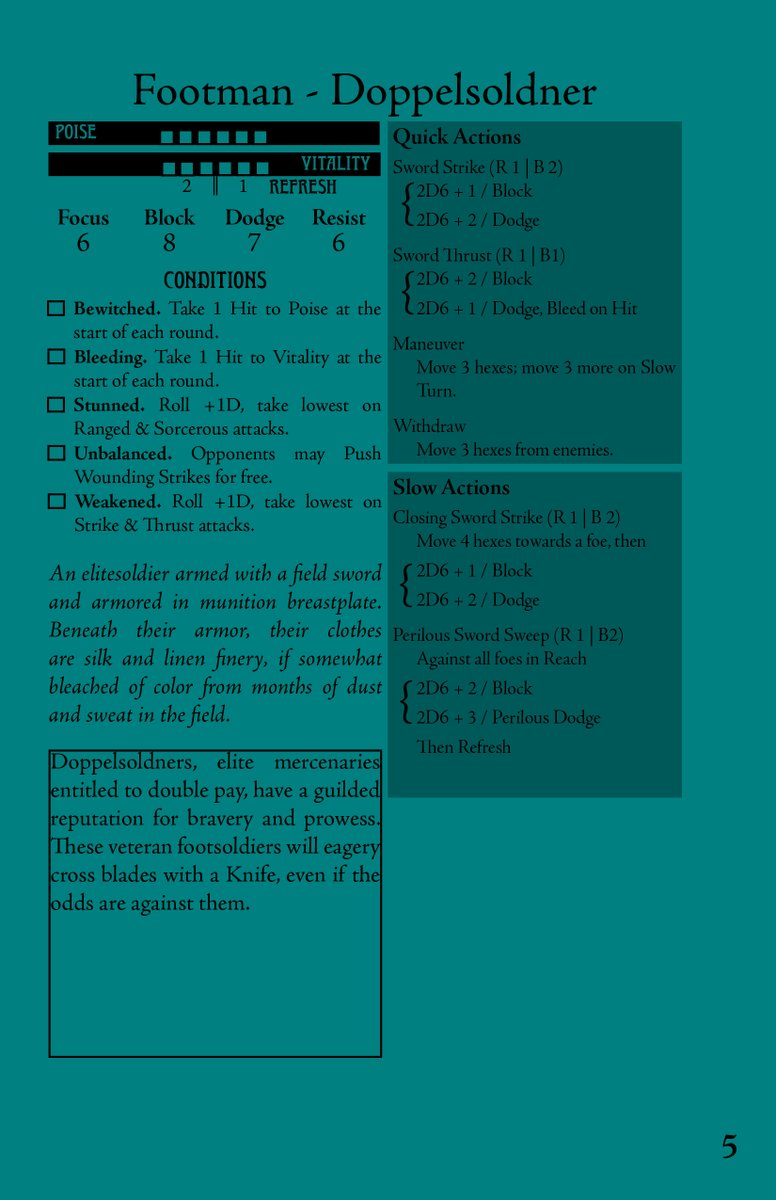I want to do a little thread on #KnivesAtKnightfall& #39;s design, but have had trouble focusing. You know. Because of the troubles.
Gonna give it a shot.
Gonna give it a shot.
The starting point is playing #SEKIRO in April 2019.
This was my third time trying to play a FromSoftware game, after bouncing off the first Dark Souls and getting a couple bosses deep in Bloodborne. (I& #39;ve since beat Bloodborne and Dark Souls 3).
This was my third time trying to play a FromSoftware game, after bouncing off the first Dark Souls and getting a couple bosses deep in Bloodborne. (I& #39;ve since beat Bloodborne and Dark Souls 3).
A thing Sekiro does is focus on posture over hit points. You have to break an opponent& #39;s posture before you can strike a deathblow, and posture refills if you don& #39;t keep the pressure on.
I saw a decent bit of chatter around trying to do something similar in a table top game.
I saw a decent bit of chatter around trying to do something similar in a table top game.
Some disclaimers:
-Hit Points, in most fantasy adventure games, do not represent meat or bodily injury (until they run out). So, in a way, HP already models the fiction.
-Other games have tried to model a distinction between "whiff points" and "meat points."
-Hit Points, in most fantasy adventure games, do not represent meat or bodily injury (until they run out). So, in a way, HP already models the fiction.
-Other games have tried to model a distinction between "whiff points" and "meat points."
The thing I set out to do with Knives at Knightfall is to try and find tabletop mechanisms that get close to the feel of Sekiro& #39;s swordplay.
The first step is modeling the relationship between having the posture to parry and deflect strikes and the getting stabbed.
The first step is modeling the relationship between having the posture to parry and deflect strikes and the getting stabbed.
See Poise, Vitality, and Refresh.
Poise represents a character& #39;s ability to dodge, deflect, and parry incoming attacks. Vitality is their "life."
Poise is a smaller pool, but is much easier to "Refresh."
Vitality is a larger pool, but losing it decreases "Refresh."
Poise represents a character& #39;s ability to dodge, deflect, and parry incoming attacks. Vitality is their "life."
Poise is a smaller pool, but is much easier to "Refresh."
Vitality is a larger pool, but losing it decreases "Refresh."
(Is this showing up green for anyone else? They& #39;re jpegs, so transparency shouldn& #39;t be an issue. . . odd)
To try and keep some of the gamey (gamific, @axesnorcs?) feeling, the player usually decides how their character defends against an attack, and therefore which pool, Poise or Vitality, is at risk.
The intent is to model the agency over play you have in an action video game.
The intent is to model the agency over play you have in an action video game.
Do you block, try to active parry, or dodge out of the way?
In a lot of tabletop games, this is dependent on the type of attack you& #39;re receiving.
In a FromSoftware game, there& #39;s often a best approach to a given enemy, but you choose how you respond to an attack in the moment.
In a lot of tabletop games, this is dependent on the type of attack you& #39;re receiving.
In a FromSoftware game, there& #39;s often a best approach to a given enemy, but you choose how you respond to an attack in the moment.
There is a risk/reward aspect to this decision in Knives at Knightfall. If you defend with Poise, you always lose at least a little. If you defend with Vitality, you might get out of the way entirely, but if you get hit, it has a bigger impact on you long term.
Another aspect of modeling this kinetic space is how we handle initiative and decision making.
Near the start of the round, the GM declares what the enemies are doing, in narrative terms and in terms of when the action will happen in the round.
Player characters are different.
Near the start of the round, the GM declares what the enemies are doing, in narrative terms and in terms of when the action will happen in the round.
Player characters are different.
Player characters each act once in a round, but they choose in the moment, depending on the kind of action they& #39;re doing.
This is something borrowed from Shadows of the Demon Lord, as described to me, then filtered through Knives at Knightfall& #39;s needs.
This is something borrowed from Shadows of the Demon Lord, as described to me, then filtered through Knives at Knightfall& #39;s needs.
You may notice that the choice of action a player makes is also a choice of which of their opponent& #39;s defenses they attack!
Again, the intent is to give the player the feeling that they& #39;re controlling their character and that their choices in a conflict impact their outcomes.
Again, the intent is to give the player the feeling that they& #39;re controlling their character and that their choices in a conflict impact their outcomes.
Notice how each attack has two lines connected by a bracket? The GM uses a different line, depending on how the player character chooses to defend.
Generally, "strikes" are easier to block. "Thrusts" to dodge.
This creates a space where players can make informed decisions.
Generally, "strikes" are easier to block. "Thrusts" to dodge.
This creates a space where players can make informed decisions.
This is my answer to the old yarn about making tabletop games inspired by video games. It is not a fruitless endeavor to try and model their kinesthetic feel in a non-kinesthetic medium.
If you want to check out Knives at Knighfall, you can find it at http://bad-quail.itch.io/knives-at-knightfall">https://bad-quail.itch.io/knives-at...
If you want to check out Knives at Knighfall, you can find it at http://bad-quail.itch.io/knives-at-knightfall">https://bad-quail.itch.io/knives-at...

 Read on Twitter
Read on Twitter




